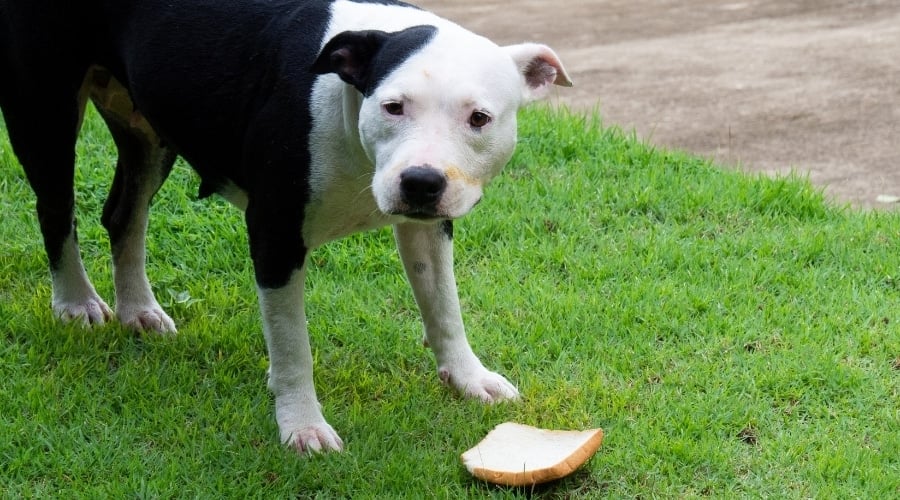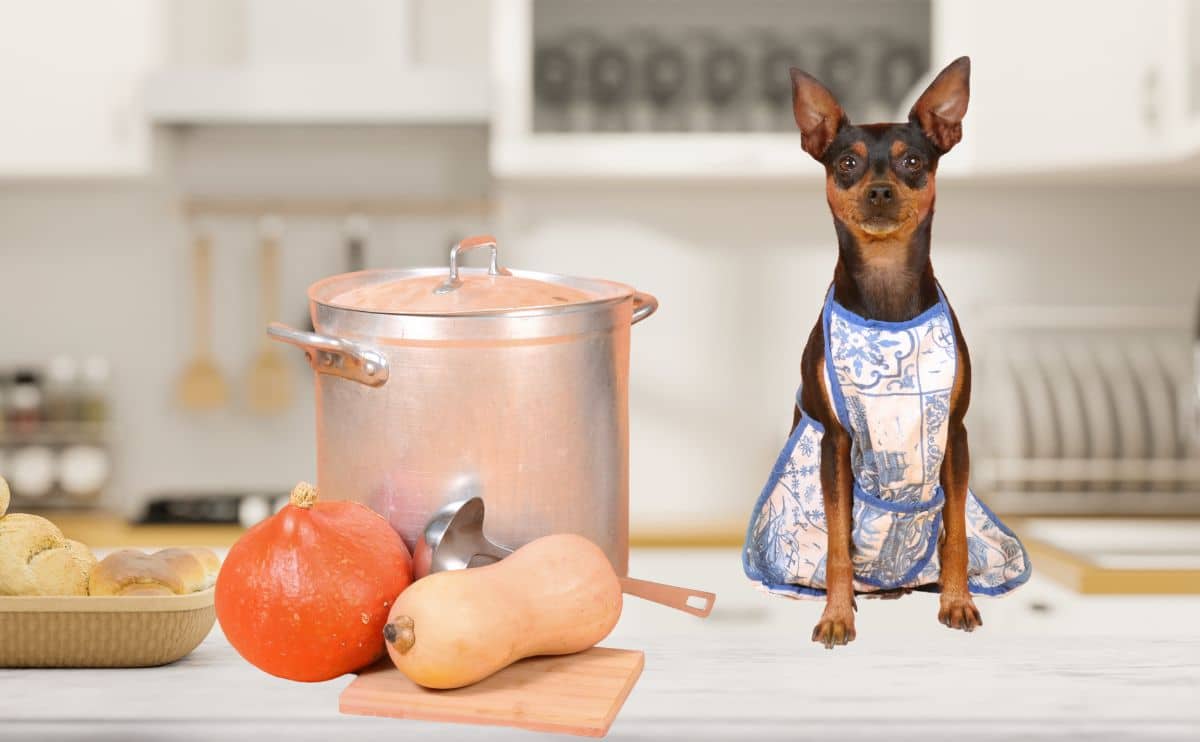My Dog Just Ate An Entire Loaf Of Bread! What Should I Do Now?
When you purchase through links on our site, we may earn a commission. Here’s how it works.
No matter your dog’s size, bread is something that most dogs quickly develop a fascination with. Usually, it starts as a table scrap or a temporary treat during training sessions. No matter the type of dog you have, it’s not uncommon for a piece of bread to get them drooling in seconds flat. But what happens when your pup eats bread but eats way too much of it?
When eaten in moderation, most bread is fairly harmless. But if Fido ate a full loaf, it can cause constipation and other symptoms. Some types of bread include ingredients that could be very toxic for your pup.
So when should you worry? In the article below, we will walk through what you can expect if your dog ate a little bread or an entire loaf. We also explain what you’ll likely want to look out for and when it’s time to call your veterinarian. Let’s jump in!
Table of Contents
Is Bread Bad For Dogs?
The short answer is no. In small quantities, it is unlikely that bread will cause any harm. There is one caveat to this, of course. It truly depends on the ingredients the bread contains. Most standard white or wheat bread is fine in small moderation. However, bread that has raisins in it, such as a fruit loaf, is potentially toxic, so an immediate trip to the veterinarian is advised.
Quantity matters as well. If a dog eats the same amount of plain white bread, this is not likely to be problematic. Of course, if your canine companion eats a very large quantity of bread, such as a whole loaf, a whole French breadstick, or a pack of bread rolls, this could cause symptoms such as abdominal pain, constipation, and bloat.
My Dog Ate A Full Loaf! What Now?

So your dog decided to eat an entire loaf? There are some steps that you’ll want to follow, depending on the type of bread that was consumed and how much was eaten. Follow these steps below to make sure there are no issues with your pup.
Step #1: Stop Fido from eating more bread
Try and remove Fido from the area to stop them from eating any more bread or packaging. You can place your pup in their crate or move them to a secure location where there’s no access to bread or any other foreign body.
Step #2: Check for life-threatening symptoms
Are they okay, or are they showing any signs of being unwell? Is there any bloat, vomiting, or diarrhea? Are they acting lethargic, or are they pacing around the house looking restless? These are all causes for concern, and you’ll want to make sure you have checked these symptoms and written them down before calling your veterinarian.
Step #3: Gather evidence, and write it down
Try and work out what type of bread was eaten. Look for the wrapper or any leftover bread to try and see what type it was and what ingredients it might have contained. If there’s anything toxic in the ingredient list, you’ll want to make sure to cover that with your vet in the next step.
Step #4: Call your veterinarian
If you suspect your pup has eaten bread containing potential toxins, such as raisins, xylitol or onions then call your veterinarian immediately. You will also need to call if they have eaten a large quantity of bread or if you suspect the bread may have been moldy.
Step #5: Follow your veterinarian’s advice
Your vet may advise you that your pup should be seen in the office. You’ll definitely have a vet’s visit if there is something toxic in the bread or if they are displaying any symptoms of bloat or other illnesses. Follow your vet’s guidance from this point on, which could be to monitor their symptoms or other steps listed below.
What Can I Do If My Dog Ate A Full Loaf?

This depends on the type of bread that has been eaten! Most normal baked white or wheat bread is very unlikely to cause serious issues. Your pup may suffer from some abdominal discomfort or mild bloating due to the large amount consumed.
If the bread is moldy or contains any ingredients that are toxic to dogs, then other symptoms may be seen. The following is a list of common toxic ingredients found in some specialty loaves. If any of these ingredients are on the packaging and were consumed, contact your veterinarian straight away.
Onions
Some bread might contain ingredients such as onions to give them extra flavor. Onions in large quantities can cause toxicity in dogs. They cause oxidative damage, which can affect red blood cells, creating a serious condition called hemolytic anemia. Symptoms may not be seen straight away, but dogs can go on to develop serious illnesses over time.
Garlic
Garlic, like onions, can cause oxidative damage to red blood cells, meaning they break more easily, leading to hemolytic anemia. This anemia can cause weakness and collapse. Garlic bread should, therefore, not be fed to dogs.
Xylitol
Some breads – especially diabetic or ‘diet’ types- can contain an artificial sweetener called xylitol. Xylitol can be used in some bread-based food products, like donuts. However, the same plant-derived substance as xylitol is also called “birch sugar” or “birch sap” in ingredient listings, so watch out for those ingredients as welll.
When dogs eat even small quantities of these ingredients, it can cause them to release an inappropriate amount of insulin, causing a rapid drop in blood sugar. If left untreated, this hypoglycemia can cause seizures and even death.
Raisins
Raisins are made of grapes, and both are toxic to dogs. Many fruit loaves and pastries can contain raisins which have the potential to be extremely toxic. The exact mechanism of toxicity is unknown, but in some dogs, it can cause kidney failure. Immediate treatment from a veterinarian is advised if any raisins were consumed.
Chocolate
Some sweet loaves like banana bread, brioche, or pastries may contain chocolate. Dogs can’t metabolize the theobromine contained in chocolate, so it has the potential to cause liver failure if eaten in toxic quantities. Smaller dogs are more susceptible to the effects of chocolate, and dark chocolate is particularly dangerous.
Nuts
Macadamia nuts are toxic to dogs and can cause symptoms such as tremoring, hindlimb weakness, and vomiting. Walnuts have also been associated with toxicity in dogs, so bread containing nuts should be avoided.
Bread Dough
It is also worth mentioning raw bread dough too. If a dog consumes a reasonable amount of uncooked bread dough, this could cause problems. Raw bread dough containing yeast will expand in your dog’s warm stomach, causing bloating and abdominal discomfort. The yeast can also ferment, releasing harmful ethanol. This will become absorbed into their bloodstream leading to weakness, lethargy, and collapse.
What Happens At The Veterinarian Clinic?

If your veterinarian is concerned about the volume of bread eaten or if they have eaten any of the previously listed toxic ingredients, then they will advise you to bring your pup into the clinic for an examination. Your veterinarian will perform a physical examination to look at your dog’s overall demeanor and assess them for any signs of abdominal discomfort.
The veterinarian may suggest medication to induce vomiting so that they bring up most of the bread and stop any further digestion.
In some cases, it may be necessary to run additional diagnostics such as blood tests- particularly if your dog has eaten bread containing potentially toxic ingredients. Similarly, if your pet is poorly and in need of supportive treatment, they may recommend that he stays in the clinic for monitoring.
If your dog has consumed any plastic wrapping, then there may be concerns about it causing a physical obstruction. This will also be the case if the bread is wrapped in any type of thicker paper product. If either of these is true, further diagnostics may be required, such as X-rays or ultrasounds.
Will My Dog Be Okay?
A full loaf is quite a large quantity for one dog to eat! Any dog that eats a lot of bread in one go could experience things such as bloating, discomfort, and gastrointestinal upset. If the wrapper has been consumed as well as the bread, then this could potentially cause a physical obstruction which can be serious. If you notice diarrhea, vomiting, or bloat after eating bread, you should call your veterinarian for advice.
Any further side effects will depend on what the bread contains. Some loaves have ingredients that are highly toxic to dogs, so you should call your veterinarian straight away. Also, if your dog is diabetic, then eating something outside of his normal diet may cause issues with his blood sugar management, so again it would be worth calling your veterinarian to discuss things further.
Frequently Asked Questions
Is it safe to feed dogs bread?
Most healthy dogs will be fine eating a small amount of plain bread occasionally, but the advice would be to stick to their normal diet, as bread can add extra calories to their diet, increasing their risk of obesity. You should avoid feeding your dog any pieces of bread that contain ingredients that are toxic to them (onions, chocolate, xylitol, etc.).
Will bread settle a dog’s stomach?
If you are concerned about your dog’s upset stomach, it would be best to contact your veterinarian for advice. Whilst a bit of plain bread is unlikely to do your pet any harm, there are more effective treatments and diets available to help with gastrointestinal upset.
What happens if my dog eats moldy bread?
Mold contains mycotoxins which can cause serious side effects such as vomiting, tremoring, and seizures. The toxins can also cause irreversible liver damage and even death. Your dog will require intensive veterinary treatment if they are affected. Try to make sure your dog can’t raid any trash cans at home and put them on a lead where people may have discarded bread- such as near duck pounds or bird feeders.
Is seeded bread okay for dogs?
Bread that contains seeds is unlikely to cause any specific issues to your dog if fed on occasion in small quantities, but again if it contains any toxic ingredients, it should be avoided. You should avoid giving bread to your dogs regularly, as it contains a lot of calories and can make obesity more likely.
Can I feed my dog sourdough bread?
There are no specific concerns with feeding sourdough bread to dogs over any other type of bread, but again it wouldn’t be advised due to adding unnecessary calories to their diet.
Can I feed my dog rye bread?
Small amounts of rye bread should not cause any issues to your dog, but consider that feeding your dog any sort of bread regularly can add empty calories to his diet and cause unhealthy weight gain.
Is pumpkin bread okay for dogs?
Pumpkin bread eaten occasionally in small quantities should be fine for most dogs as long as it doesn’t contain toxic ingredients like raisins. It usually contains more dietary fiber and might be less processed than some other bread. However, you shouldn’t make a habit of feeding your dog bread, as it’s very fattening.
Final Thoughts
In summary, normal plain bread is unlikely to cause too much concern to healthy dogs if consumed in small quantities. But remember, you should try not to feed your dog things that are outside of his normal diet, and bread won’t add much nutritionally- except extra calories.
Try and keep any bread well out of the way from your dog’s reach at home to avoid scavenging, and call your veterinarian if you have any concerns, especially if he eats a large quantity or if it contains any potentially toxic ingredients.



